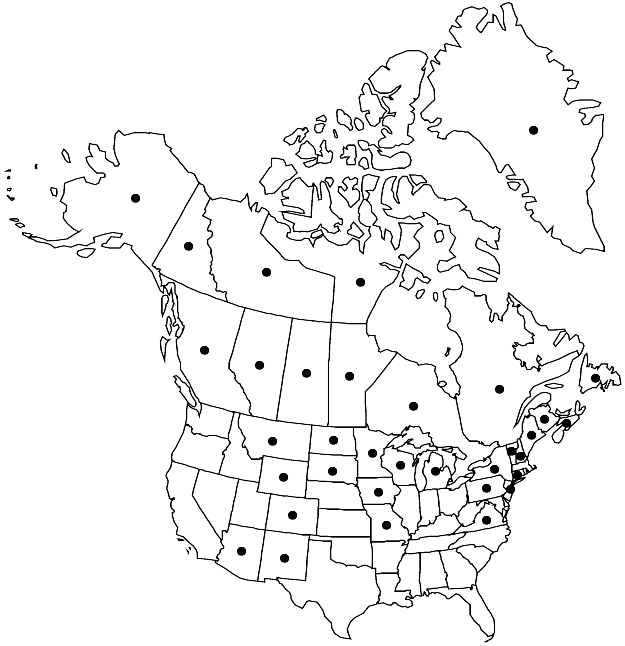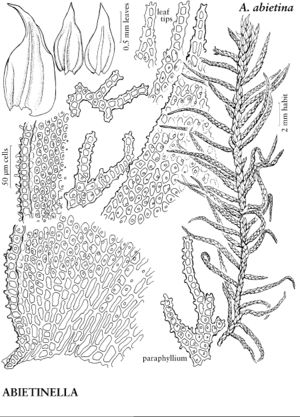Difference between revisions of "Abietinella abietina"
Musc. Buitenzorg 4: 1497. 1923.
FNA>Volume Importer |
imported>Volume Importer |
||
| (3 intermediate revisions by 2 users not shown) | |||
| Line 9: | Line 9: | ||
|special_status={{Treatment/ID/Special_status | |special_status={{Treatment/ID/Special_status | ||
|code=F | |code=F | ||
| − | |label= | + | |label=Illustrated |
}} | }} | ||
|basionyms={{Treatment/ID/Basionym | |basionyms={{Treatment/ID/Basionym | ||
|name=Hypnum abietinum | |name=Hypnum abietinum | ||
|authority=Hedwig | |authority=Hedwig | ||
| + | |rank=species | ||
|publication_title=Sp. Musc. Frond., | |publication_title=Sp. Musc. Frond., | ||
|publication_place=353 [added post-publ.]. 1801 | |publication_place=353 [added post-publ.]. 1801 | ||
| Line 20: | Line 21: | ||
|name=Thuidium abietinum | |name=Thuidium abietinum | ||
|authority=(Hedwig) Schimper | |authority=(Hedwig) Schimper | ||
| + | |rank=species | ||
}} | }} | ||
|hierarchy=Thuidiaceae;Abietinella;Abietinella abietina | |hierarchy=Thuidiaceae;Abietinella;Abietinella abietina | ||
| Line 44: | Line 46: | ||
-->{{#Taxon: | -->{{#Taxon: | ||
name=Abietinella abietina | name=Abietinella abietina | ||
| − | |||
|authority=(Hedwig) M. Fleischer | |authority=(Hedwig) M. Fleischer | ||
|rank=species | |rank=species | ||
| Line 58: | Line 59: | ||
|publication title=Musc. Buitenzorg | |publication title=Musc. Buitenzorg | ||
|publication year=1923 | |publication year=1923 | ||
| − | |special status= | + | |special status=Illustrated |
| − | |source xml=https:// | + | |source xml=https://bitbucket.org/aafc-mbb/fna-data-curation/src/2e0870ddd59836b60bcf96646a41e87ea5a5943a/coarse_grained_fna_xml/V28/V28_588.xml |
|genus=Abietinella | |genus=Abietinella | ||
|species=Abietinella abietina | |species=Abietinella abietina | ||
Latest revision as of 21:36, 5 November 2020
Plants dark green, yellowish brown, or dark brown, sometimes blackish tinged. Stems to 12 cm; branches short, unequal, tapered; paraphyllia many. Stem leaves erect when dry, erect-spreading when moist, orange at insertion, plicate, 1.2–1.8 mm. Branch leaves erect when dry, erect-spreading when moist, 0.6–0.7 mm; costa strong. Perichaetial leaves to 4 mm. Seta 2–2.5 cm. Capsule yellow-brown, 2–3 mm. Spores 9–11 µm, finely papillose.
Phenology: Capsules mature late summer.
Habitat: Dry, exposed calcareous rock and soil, sand of partially stabilized dunes, talus at base of cliffs, humus in open, coniferous forests
Elevation: low to moderate elevations
Distribution

Greenland, Alta., B.C., Man., N.B., Nfld. and Labr. (Nfld.), N.W.T., N.S., Nunavut, Ont., Que., Sask., Yukon, Alaska, Ariz., Colo., Conn., Iowa, Maine, Mich., Minn., Mo., Mont., N.H., N.J., N.Mex., N.Y., N.Dak., Pa., S.Dak., Vt., Va., Wis., Wyo., Europe, Asia.
Discussion
Abietinella abietina is the easiest of the Thuidium-like plants to recognize in the flora area, in part because of its distinctive habitat requirements. The stems are 1-pinnate, erect-ascending, and often occur in extensive, lax mats. Paraphyllia are abundant on stems and branches, but are usually not nearly as strongly branched as in Thuidium in the narrow sense. Abietinella abietina is widespread throughout the northern part of the flora. The capsules of this species are very rare. Unlike Thuidium, Abietinella is papillose on both leaf surfaces rather than just the back.
Selected References
None.
